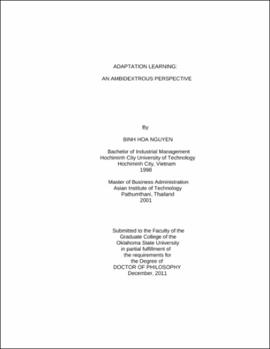| dc.contributor.advisor | Frankwick, Gary Lynn | |
| dc.contributor.author | Nguyen, Binh Hoa | |
| dc.date.accessioned | 2013-11-26T08:25:41Z | |
| dc.date.available | 2013-11-26T08:25:41Z | |
| dc.date.issued | 2011-12 | |
| dc.identifier.uri | https://hdl.handle.net/11244/6819 | |
| dc.description.abstract | Scope and Method of Study: The dissertation examines whether adaptation, through ambidexterity, helps firms improve their performance. Adaptation ambidexterity is an intrafirm process of balancing and integrating exploration and exploitation learning in a firm's partner-specific investment strategy to develop products according to that partner's changing requirements. Specific research questions are whether: (1) adaptation ambidexterity improves new product performance, and (2) whether the marketing environment characteristics of adaptation (market turbulence, technological turbulence, and partner dependence) affect that relationship. To address these concerns, the dissertation develops scales for adaptation ambidexterity, adaptation balance and adaptation integration. Then, moderated regression is used for main effects and moderation effects. The study employs a cross-sectional design and examines the hypothetical relationships. Key participants to be surveyed were determined using a random list of US high-tech manufacturing firms. | |
| dc.description.abstract | Findings and Conclusions: The results show that adaptation ambidexterity is an important factor that influences new product performance. First, adaptation integration, one of the two components of being ambidextrous, has strong and consistent effects on new product performance. Second, under low market turbulence, low technological turbulence, and low partner dependence adaptation balance may in fact negatively affect performance. Under the high levels of these factors, adaptation balance is non-detrimental condition for ambidexterity. This finding confirms the fact that being balanced without justification may harm business performance. Finally, the negative interaction effect of adaptation integration and technological turbulent environment in this study in fact suggest that adaptation integration is more effective in low technological turbulence that in high technological turbulence. | |
| dc.format | application/pdf | |
| dc.language | en_US | |
| dc.rights | Copyright is held by the author who has granted the Oklahoma State University Library the non-exclusive right to share this material in its institutional repository. Contact Digital Library Services at lib-dls@okstate.edu or 405-744-9161 for the permission policy on the use, reproduction or distribution of this material. | |
| dc.title | Adaptation learning: An ambidextrous perspective | |
| dc.contributor.committeeMember | Arnold, Todd James | |
| dc.contributor.committeeMember | Flaherty, Karen E. | |
| dc.contributor.committeeMember | White, Margaret A. | |
| osu.filename | Nguyen_okstate_0664D_11714 | |
| osu.accesstype | Open Access | |
| dc.type.genre | Dissertation | |
| dc.type.material | Text | |
| dc.subject.keywords | adaptation | |
| dc.subject.keywords | ambidexterity | |
| dc.subject.keywords | organizational learning | |
| thesis.degree.discipline | Marketing | |
| thesis.degree.grantor | Oklahoma State University | |
